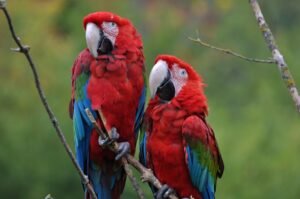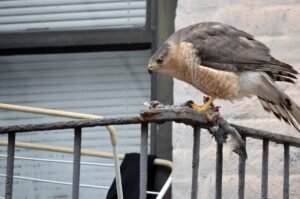White tree frogs (Litoria caerulea), also known as dumpy tree frogs or Australian green tree frogs, are a species native to Australia and New Guinea. These amphibians have gained popularity as pets due to their docile temperament, distinctive appearance, and relatively low maintenance requirements. Their common name derives from their pale coloration, which ranges from milky white to light green, providing effective camouflage against tree bark in their natural environment.
During the breeding season, male white tree frogs produce a distinctive vocalization described as a deep, resonant “wark wark” sound. This species has become a common choice for exotic pet enthusiasts and herpetologists due to its unique characteristics and adaptability to captive conditions.
Key Takeaways
- White tree frogs are a popular species of tree frog known for their distinctive white coloration and large size.
- These frogs are native to Australia, Indonesia, and Papua New Guinea, and are commonly found in tropical and subtropical forests.
- White tree frogs have a plump body, large toe pads, and a distinctive white or cream coloration, although they can also be found in shades of green and brown.
- These frogs are nocturnal and primarily insectivorous, feeding on a diet of crickets, moths, and other small insects.
- When kept as pets, white tree frogs require a large, vertically oriented enclosure with plenty of foliage, humidity, and a diet of live insects.
Habitat and Distribution of White Tree Frogs
Habitat and Distribution
They are commonly found near water sources such as ponds, streams, and swamps, where they can breed and find food. These frogs are native to northern and eastern Australia, as well as parts of New Guinea.
Adaptations and Behavior
They are well adapted to living in trees and are often found perched on branches or hiding in foliage during the day. White tree frogs are nocturnal, meaning they are most active at night when they hunt for insects and other small prey.
Success and Distribution
Their ability to thrive in a range of environments has contributed to their widespread distribution and success as a species.
Physical Characteristics of White Tree Frogs

White tree frogs are medium-sized amphibians with a distinctive appearance. They have large, round eyes with horizontal pupils, which give them excellent vision and depth perception. Their skin is smooth and moist, helping them to absorb water and stay hydrated.
As their name suggests, these frogs are typically white or pale green in color, although they can also be shades of blue or brown. They have sticky toe pads that allow them to climb and cling to surfaces, making them well adapted to life in the trees. White tree frogs have a plump body and short limbs, giving them a cute and chubby appearance that adds to their appeal as pets.
White tree frogs are known for their ability to change color based on their environment and mood. They can become darker or lighter in response to temperature, humidity, and stress. This color-changing ability helps them camouflage and regulate their body temperature in different conditions.
Additionally, white tree frogs have a distinctive call that they use to communicate with other frogs during the breeding season. Their call is loud and resonant, making it easy to identify them in the wild.
Behavior and Diet of White Tree Frogs
| Behavior and Diet of White Tree Frogs | |
|---|---|
| Behavior | Arboreal (tree-dwelling) and nocturnal |
| Activity | Mostly active at night, resting during the day |
| Feeding | Mainly insectivorous, feeding on crickets, moths, and other small insects |
| Hunting | Uses its sticky tongue to catch prey |
| Water intake | Absorbs water through its skin, but also drinks from water droplets |
White tree frogs are primarily nocturnal, meaning they are most active at night. During the day, they can be found resting on branches or hiding in foliage to avoid predators. These frogs are arboreal, meaning they spend most of their time in trees rather than on the ground.
They have excellent climbing abilities thanks to their sticky toe pads, which allow them to move easily through the branches in search of food and shelter. In the wild, white tree frogs feed on a variety of insects, including crickets, moths, flies, and beetles. They are sit-and-wait predators, meaning they patiently wait for prey to come within striking distance before capturing it with their sticky tongue.
In captivity, white tree frogs can be fed a diet of gut-loaded crickets, mealworms, waxworms, and other commercially available insects. It’s important to provide a varied diet to ensure they receive all the nutrients they need to stay healthy. White tree frogs are known for their docile nature and tolerance of handling, making them popular pets for both beginner and experienced amphibian keepers.
They are generally calm and easy to handle, although it’s important to wash your hands before and after handling them to avoid transferring any harmful substances or bacteria.
Captive Care and Maintenance of White Tree Frogs
Caring for white tree frogs in captivity requires a suitable enclosure with the right environmental conditions. A glass terrarium or plastic enclosure with a secure lid is ideal for housing these frogs, as it provides good visibility and ventilation while preventing escape. The enclosure should be large enough to accommodate multiple frogs if you plan to keep more than one together.
White tree frogs require a warm and humid environment to thrive. The temperature in their enclosure should be maintained between 75-85°F (24-29°C) during the day and slightly cooler at night. A heat source such as a low-wattage heat lamp or heat mat can be used to achieve the right temperature gradient.
It’s important to monitor the temperature regularly with a thermometer to ensure it remains within the appropriate range. Humidity is also crucial for white tree frogs, as they require moist conditions to keep their skin hydrated and healthy. A substrate such as coconut fiber or sphagnum moss can be used to retain moisture and create a humid microclimate within the enclosure.
Regular misting with dechlorinated water will help maintain the humidity level at around 50-70%. Providing live plants and a shallow water dish will also help increase humidity and create a naturalistic environment for the frogs. In addition to environmental conditions, white tree frogs require a varied diet of live insects to meet their nutritional needs.
Gut-loading insects with nutritious foods such as fruits, vegetables, and commercial insect diets will ensure they provide essential vitamins and minerals to the frogs when consumed. Dusting insects with calcium and vitamin supplements is also recommended to prevent nutritional deficiencies.
Conservation Status and Threats to White Tree Frogs

Threats to Habitat and Health
Habitat loss due to deforestation, urban development, and agriculture is a significant concern for these frogs, as it reduces the availability of suitable breeding and foraging areas. Pollution from pesticides, herbicides, and other chemicals can also negatively impact their health and survival.
Invasive Species and Climate Change
Invasive species such as cane toads pose a threat to white tree frogs by competing for resources and preying on them directly. Cane toads are aggressive predators that can outcompete native frog species for food and habitat, leading to declines in their populations. Climate change is another potential threat to white tree frogs, as it can alter their natural habitat and disrupt breeding patterns.
Conservation Efforts
Conservation efforts for white tree frogs focus on protecting their natural habitat, raising awareness about their importance in ecosystems, and implementing measures to mitigate threats such as habitat loss and pollution. Educating the public about the value of these amphibians and promoting responsible land management practices are essential for ensuring their long-term survival.
Fun Facts and Interesting Trivia about White Tree Frogs
– White tree frogs have a lifespan of 10-16 years in captivity when provided with proper care.
– These frogs have a unique defense mechanism where they secrete a sticky mucus from their skin when threatened.
– White tree frogs have been known to eat smaller frog species if they come across them in the wild.
– They are capable of surviving in urban areas and can be found in gardens, parks, and even inside buildings.
– White tree frogs have been featured in popular culture, including movies, television shows, and advertisements due to their distinctive appearance and charming personality. In conclusion, white tree frogs are fascinating amphibians with unique physical characteristics and behaviors that make them popular pets among amphibian enthusiasts. Their widespread distribution in Australia and New Guinea has contributed to their success as a species, but they face potential threats from habitat loss, pollution, invasive species, and climate change.
Conservation efforts are essential for protecting these charming frogs and ensuring their survival for future generations to enjoy. Whether kept as pets or admired in the wild, white tree frogs continue to captivate people with their endearing nature and captivating presence.
If you’re a fan of white tree frogs, you might be interested in learning about the upcoming film “Rebel Moon” directed by Zack Snyder. The film is set to feature a diverse cast of characters, including some unique creatures like the white tree frog. You can read more about the film and its exciting developments in this article.
FAQs
What are white tree frogs?
White tree frogs, also known as dumpy tree frogs or Australian green tree frogs, are a species of tree frog native to Australia, Indonesia, and Papua New Guinea.
What do white tree frogs look like?
White tree frogs are typically a light green or white color, with smooth skin and large, round eyes. They have a plump body and sticky toe pads that help them climb and cling to surfaces.
What do white tree frogs eat?
White tree frogs are carnivorous and primarily eat insects such as crickets, moths, and flies. They may also consume small vertebrates such as other frogs or small lizards.
How big do white tree frogs get?
Adult white tree frogs can grow to be around 2 to 3 inches in length, with females typically being larger than males.
What kind of habitat do white tree frogs need?
White tree frogs are arboreal, meaning they live in trees and shrubs. They require a humid environment with plenty of foliage and hiding spots, as well as access to water for soaking and hydration.
Are white tree frogs good pets?
White tree frogs are popular as pets due to their docile nature and relatively low maintenance requirements. However, potential owners should research their care needs and be prepared to provide a suitable habitat and diet.
Are white tree frogs endangered?
White tree frogs are not currently considered endangered, but their populations in the wild are threatened by habitat loss and pollution. It is important to support conservation efforts and responsible pet trade practices to help protect their natural habitats.




















+ There are no comments
Add yours